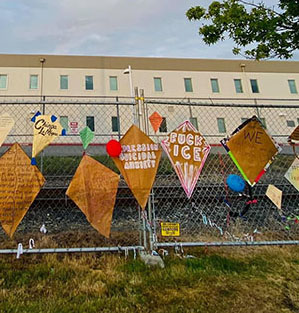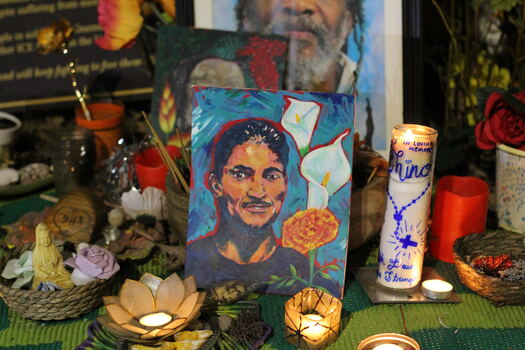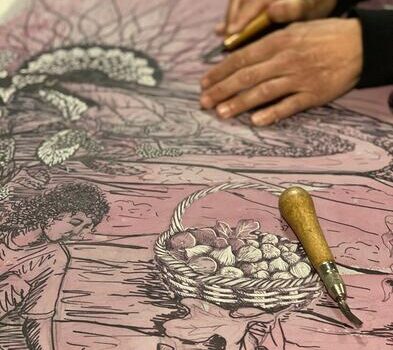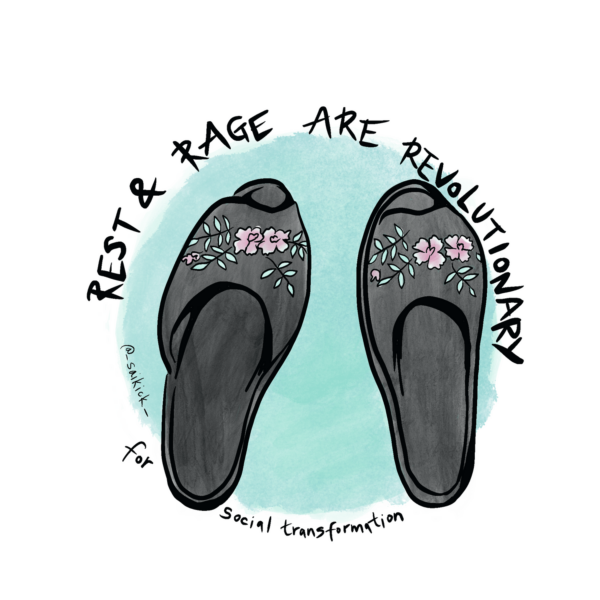As we witness the world around us in transformation, remediation, some may say chaos, in this fight for our lives, and while the whole world is ablaze (literally and figuratively) with uprisings, I have also been experiencing more moments of pause; trying to stay attuned with more attentiveness to these moments, dreams and symbols that spark some intrigue and even synchronicities. We know that the global COVID-19 pandemic has unearthed and exasperated inequities, state violence and repression of those already most oppressed. Undocumented people detained in the United States have been more so negatively impacted with compounding fear to a population already at their wits end by separation of their families and risk of deportation. Mass incarceration is already a known medical emergency.
On the traditional lands of the Puyallup People also known as Tacoma, Washington the Northwest ICE Processing Center (NWIPC) still commonly known as Northwest Detention Center (NWDC) has been in operation, caging, transferring and deporting immigrants during this pandemic. This is a for-profit detention facility run by the corporation GeoGroup in contract with Immigration and Customs Enforcement (ICE) with a 1,575 bed quota to fill.
Most recently, La Resistencia (a grassroots volunteer undocumented led group fighting alongside people detained at NWDC to end all detentions, deportations, and to shutdown NWDC) continue to release calls to action on their social media platforms as more information from people detained is shared about those inside contracting Covid-19. There have already been several workers in the facility who have become COVID-19 positive over the last few months along with transfers to the facility being COVID-19 positive. One COVID-19 positive contracted employee knowingly went to work and has since been fired.
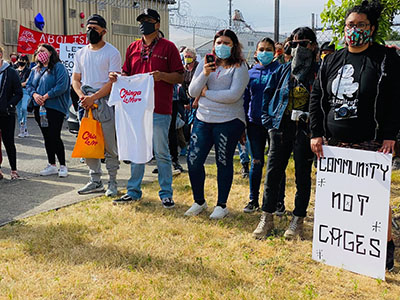
All the while hunger strikes by some people detained continue inside of NWDC to demand the immediate release of those with illnesses and chronic medical conditions before freeing them all. Victor Fonseca, from Venezuela has surpassed 55 days on hunger strike so far with some health complications including kidney failure. He is choosing to remain on hunger strike indefinitely until he, those with illnesses and then everyone else is released, even after recent threats of force feeding by guards. Abstaining from food to protest the dangerous conditions is something that not everyone who is practicing is verbalizing for fear of retaliation from ICE and GeoGroup officers. Current five people are still on hunger strike. Three other people so far have also been in medical isolation with signs on their doors describing respiratory needs and dangers of getting close.
Rene Alatorre was released from NWDC on December 8th after an extensive public campaign with La Resistencia and his legal representative Eliana Horn of Colectiva Legal del Pueblo. Rene said, “ I saw from my cell Geo guards dressed as if they were going to the moon! All covered up to take food to the other guys [in medical isolation] and then disposing of it in separate plastic bags. While Victor [Fonseca] and I received food in regular plastic food trays, and guards didn’t wear the PPE when they came near us.” Over the last few months at least four workers are known to have contracted COVID-19 that have put many people in detention at risk of contracting the virus. On average each week one or two pods (the units where people are detained) have been under quarantine since this past summer.
The first time I showed up to NWDC was as a student with friends to a rally in 2014. One of the biggest hunger strikes taking place inside of the detention center was taking place in response to mistreatment and La Resistencia was hosting a solidarity action. This moment was the beginning of an era set forth by people detained organizing from inside NWDC in collaboration with people outside. Over the years I had shown up to learn what was going on inside, take photos and share on my social media so that more people would know what was going on. It was a place I heard of years prior when one of my family members was detained there but nothing we spoke of as a family. Becoming part of the La Resistencia family enabled me to understand the experience of my loved one and the experience of too many families’ loved ones by showing up and listening. As someone who has the privilege of not having to fear being caged for the lack of papers, I feel the utmost responsibility to support this fight until this facility and all detention centers are closed for good.
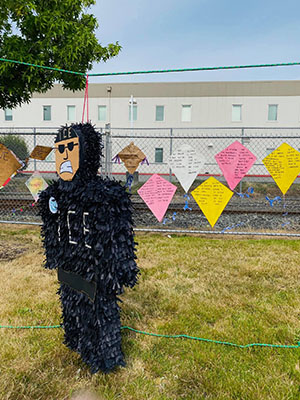
This past year has been a time for deep reflection. I started writing this blog surrounded by smoke, lungs heavy and grieving for last breaths stolen in the streets by police. I was encouraged to share something regarding “Listening as a Radical Act” as fellow Justseeds artist Thea Gahr had titled this for me, as we walked past translucent snakeskin shed away by a slithery friend. We were walking lands less tampered beside a mowed path, guiding us around dried out pasture on the edges of our hometown in Oregon one summer weekend. I was inquiring about anarchy and sharing my frustrations about seemingly new activists and reactionaries. On this walk I was recalling the fourth of July, where there was a solidarity event organized by La Resistencia at NWDC. On this monthly solidarity day, hundreds of people had shown up to share prayers, words of solidarity, listen to testimony of families with loved ones detained inside and fly kites, as another way for people in the yard to see that we were fighting for them on the outside. (Kites are also the name of the grievance system inside of the detention center. A symbolic gesture of paper kites with individual’s grievances were adhered to the fence.)
Toward the end of the program there was some commotion in the back of the crowd. A group of younger people dressed in all black, ski masked, and even some with shields in hand had begun to spray paint a detention center office space with “FUCK ICE” and anarchist symbols. Some of my comrades tried to deescalate the situation and some even put their own bodies between the building wall and these young activists. They were asking them to stop tagging and asked if they knew why folks were here; knowing that any escalation of the solidarity day could provoke the detention center with surveillance cameras around the building to call the police. Police presence could have become dangerous for anyone attending in solidarity for folks inside, for the families with small children and some openly undocumented organizers were present. Long time organizers working with people detained are also fully aware that any act of resistance is risky for people in detention. Many people inside have been subjected to retaliation by officers for going on public hunger strike and giving bad publicity to the facility. Often this means a punishment of solitary confinement or a quicker deportation sentence.
In the attempts at countless conversations with the young activists there was not much listening, less understanding or awareness of the context we were all involved in. The fiery spirited activists were frustrated that their tactic was not being welcomed and their freedoms being silenced.
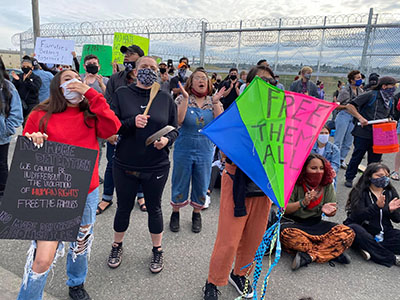
Particularly during this time there had been a surge of new organizers and groups formalizing. Groups coming from the shadows to put on rallies, stage marches and gain public attention on social media and by officials in Tacoma after the murder of George Floyd. They have been making a lot of noise unlike anything I had ever seen before in Tacoma. Rooted in the fight for Black Lives, many of these organizers can name and probably quote some renowned abolitionists yet still fall back on reformist strategies in their reasoning of their calls to action. Where I have found frustration as someone who has shown up to actions for the past few years (still feeling fairly new to the organizing scene in my opinion) I witness some of the new organizers pursuing spotlight attention instead of engaging or listening to the demands of those who have been doing this work far beyond the few months they have found their vigor and voice in the streets. Their ways were the best ways and there was not much room for dialogue outside of their own opinion. This is not to say I am not glad for this new energy towards action, it is HOW these actions are being done and with regards to whom’s safety I am more concerned about.
What didn’t seem to align for me was this notion of Anarchy being demonstrated that did not align with principles I am still understanding of what this philosophy believes. In Fred Woodworth’s essay “Anarchism: What is it? Is it practical or utopian? Is government necessary?” (1973) defines Anarchism as “The philosophy of a new social order based on liberty unrestricted by man-made law; the theory that all forms of government rest on violence, and are therefore wrong and harmful, as well as unnecessary.” Therefore, the Anarchist is “A believer in Anarchism; one opposed to all forms of coercive government and invasive authority; an advocate of Anarchy, or absence of government, as the ideal of political liberty and social harmony.” Often depiction in the media or in the streets, does not reflect principles that respect and contextualize these extreme and complex situations where people’s lives are at stake, yet in the name of Anarchy is much violence and destruction. For total abolition, yes there will be dismantling and rebuilding of better systems. This change happens over time that even some of the most patient of us may never get to witness in our lifetimes. So, I feel for the young activists who want change now as much as I want these toxic structures to crumble too.
Thea shared a visual example for me pertaining to housing. Anarchy allows anyone the choice of how they want to be housed. Someone who wants to live in a castle or a mansion and do that if I get to also live in the ways I wish without either of us harming each other. It is about finding a way to harmoniously coexist amongst ourselves and part of that natural world that we depend on. Thea said, “You can’t have autonomy without interdependency or the connection of all life to sustain all life.” Based on this understanding and after reflection on the experience during the solidarity event, is not my place to judge tactics as long as they are not harming those we are working with to free. By showing up to someone else’s organized event that was in coordination with organizers inside of the facility as a cover up to tag a building could have subjected the attendees to further violence and harm to those detained. People in detention did not ask La Resistencia organizers to spray paint all over the facility and in turn redirected attention from family testimonies and next action steps to the commotion in the background.
Forever learning in this movement building I don’t have many answers. One core aspect of the organizing I know of La Resistencia to stay true is being guided by those who are being detained. That the work is centered in their needs, the experiences of those who have been detained and their loved ones. By listening and being led by those most impacted by detention and their families, La Resistencia centers their campaigns, actions and leadership keeping their safety at the forefront. It’s easier said than done with all of the logistical, monetary and sometimes linguistic challenges imposed with the current privatized structures to limit contact while continuing to profit off of every avenue possible from people detained attempting to access the outside world. So much still needs to be done.

As Kevin Van Meter’s writes in “TO CARE IS TO STRUGGLE” in “PERSPECTIVES ON ANARCHY THEORY V. 14 N.1 Fall 2012” there are a multitude of challenges in this mobilizing work:
“Our task is to care together as we struggle together. By pushing forth the complexity of experience and realities that arise in caring for those who are mentally and physically ill, traumatized, dying, survivors of intimate violence and incarceration, addicted, suffering from chronic pain, struggling against the imposition of binary gender, and working in the care and medical industries our movements deepen our relationships with one another and construct new fronts for revolutionary struggle. It is these everyday realities that need to be considered on the long arc of sustained organizing and revolutionary change. Let us conclude as we have begun, by reflecting on the relationships that populate and construct our lives. As there are too many voices to be heard, too many bodies and minds that can give and need to receive care, too many struggles, and too many worlds just starting to emerge.” (56)
The answers we seek may be right in front of us if we take a moment to listen, which in this day in age is still such a radical act. What the theory of Anarchy strives for is one as Los Zapatistas say “un mundo donde quepan muchos mundos” (“a world where many worlds fit”). In that manifestation we have a choice in how we do the work to create the world within this one that does not sustain itself on exploitation. Listen to your intuition, your heart, your mind, those who have been doing the work, and those who may not yet understand the implications of their actions.
Many thanks to Thea Gahr, Sofie Webster and young Tova for encouragement, edits and imaginative conversations that kept up my momentum to finish writing over the last months. Much gratitude to La Resistencia members who took time to provide their feedback and edits for this blog post. Any further errors are my own.
(All photos were taken by Saiyare Refaei during the Solidarity Day on July 4, 2020.)
